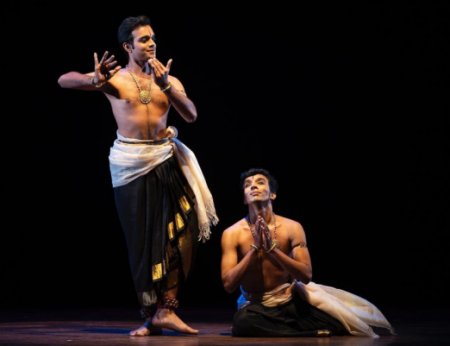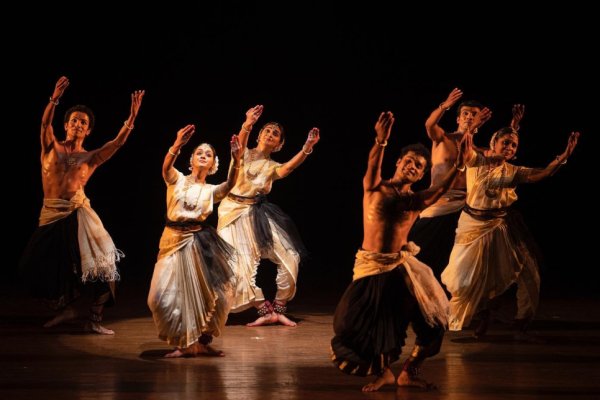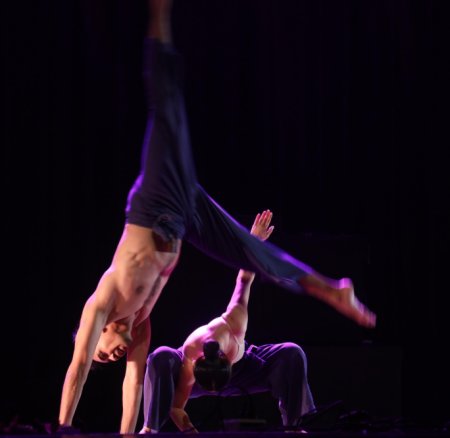
|   |

|   |
 e-mail: leelakaverivenkat@gmail.com Sparkling Spanda synergy November 18, 2022 Choreographies of Leela Samson presented by her group Spanda, at the Kamani, Delhi, showed how group energy can be an experience of immersive joy in the dancers, while executing within the same space relationships both reciprocal and distancing. Within the group symmetry, Leela's choreography getting away from the frontal faced dancing looking at the audience, comprises movements having dancers facing different directions, the simultaneity of various types of actions forming part of a larger picture not spelling dissonance. An example was the curtain raiser - an obeisance to the Sun, Bhaskaraya Namaha, based on verses taken from the Krishna Yajurveda Taittiriya Brahmana, with the Beejaksharas as the seven colours of the sun representing the seven horses of Surya's chariot. The sounds Ha and Ra, standing for Akash (the void of the sky in which the Sun rises and sets), and Agni (fire ball that the sun is) respectively, both constituents of the sun. Addressing Surya as the Mitran (friend and well-wisher) and destroyer of all evil, the dancer praying for the welfare of all, energizes her/his body, the instrument of movement, by offering salutations through the Surya Namaskar. There is stillness punctuated by sudden bursts of energy. As the sun rises, the world wakes up, with plant, bird and all living creatures coming to life. Each of these actions gets performed in unison, with dancers in varied actions facing different directions, all as part of one large frame - with Rajkumar Bharati's music in all morning ragas - Suryakanti, Ravichandrika and Surya.  Spanda (Photo: Innee Singh) The next selection based on an ashtakam Hare Hare Abheda Shahi by the 16th century Advaitin Appayar Dikshitar (whose compositions came to the aid of the philosophy of Vishistadvaitins when subjected to disruptive opposing forces) shows in a way Leela's catholic choice of themes. A Shiva Advaitin himself, Appayar Dikshitar however, ardently supported the Oneness of God, repudiating the Vaishnava/Shaiva animosity. Nursing a special corner in his heart for the Chidambaram Nataraja temple he claimed that when he stood outside, the left eye saw the shrine dedicated to Govindaraja and the right saw Nataraja, which inspired the Ashtakam describing the main traits of Shiva and Vishnu - one with his abode on the mountain heights and the other reclining in his father-in-law's home, the Ocean. One rides the Garuda and the other the Bull. "Mara janakam kumara janakam, Smaratanayam, Guhatanayam" went the words. The fact of their oneness, while representing different manifestations, in Dikshitar's treatment is underlined, with a certain lightness, far from heavy religiosity. Leela's choreography catches this joyous spirit. The music plays a big role. Starting with male/female pair standing on opposite sides of the performance area, representing the apparent Vishnu/Siva differences, the group takes one through the different moods with changing time beats in the music composed by Rajkumar Bharati's Ragamalika/Talamalika creation in Sarasangi, Kalyani and Devagandharam set to Rupakam, followed by Hamir Kalyani set to Khandam, Revati in Tisram, Tilang in Misram, and in the end Suryakanti, Chalanatai and Hindustani Madhyamawati set to Adi. Almost as a counterpoint to the group work, the next item was a straight forward, evocative, solo presentation, of a Dharmapuri Subbarayar Padam in Paras by Leela Samson. Supremely confident of her place in the lover's heart, the swadheenapatika Nayika in this composition triumphantly asks "Smarasundaranguni sari evvare?" (Who can equal my beloved in the way he loves and worships me?) Not by a whisker will he cross promises made or limits set by her. Rig Vedic chanting evokes an emotive power. As the notes of Subbarama Bhagavatar's composition "Niri nirigama garisa" started, the nritta sprint and joy of pure movement in the dancers, was infectious. And with each dancer a soloist in one's own right, the quality of dance was impeccable, as the stage was covered with dancers in various formations, coming together and separating.  Spanda (Photo: Innee Singh) Spanda's Nadi , on the theme on the river, is an older production. The river has its own philosophy, as its waters flow through different kinds of terrain, exercising a strong impression on the poetic mind and many are the works, inspired by it. Leela's choreographic impulses are prompted here by poetic sources from different corners of India - the poetry of Tagore, Sangam poetry , Girish Karnad's poem, Ras Khan's poetry, Dadra of Varanasi. So many moods find expression in the production starting with Tagore's O go Nadi in Bengali, wherein the Champa tree on one side of the flowing waters pondering on the world from its changeless position, bearing flowers, shedding old leaves and growing new ones, watching the soulful longing of Nayikas standing on the river banks, contrasts the serenity of its life rhythms, with the restless, ever moving, and mercurial river. Leela anchored on one side represented the tree, with a group of light footed jumping youngsters representing the ever moving, restless energy of the river. In a total mood change switching to Tamil poetry, the next episode based on Sangam poetry (with scholar Dr.Raghuraman helping decipher in detail) sees the high spirited energetic flow of the Vaigai waters, dancers wielding veils forming swirls and waves of a forceful river as restless rain creates confusion. Girish Karnad's Kannada poem next saying "Neeranamele Chitrakakodilla" (You cannot draw or write on the water) refers to the ever flowing nature of water which retains no memories - for it has no past, always moving and living in the eternal present. Since the lines are part of his play Hayawadhana, to respect the wishes of the poet, some folk moments with leaps, could be detected, in the otherwise Bharatanatyam inspired body language. The last verse in Urdu by Ras Khan "Kinare kinare" has the devotee praying that the lord 'help him cross the river of life and drop the anchor of the boat' on the other side. The music with all the srutibheda and notu swarams and more than one singing voice chiming in, with the danced expression made for a superb finale. Using one's art to forge unity in the country should be part of artistic responsibility. And art expressing a wide variety of themes, all underlying an essential Indianness, is a far better more intelligent way of achieving this, than through openly didactic themes. Spanda's choreography, while patterned on an overall group discipline, not dependent on robotic uniformity inspires in the dancers a sense of participative joy, with each dancer feeling that he as an individual counts. INTERFACE - A MIXED BLESSING It is after a gap of several years that one got to witness the Modern Dance creation of Kolkata's Sapphire Dance Creations headed by Sudarshan Chakravorty. The Company is celebrating its 30th year of existence - no mean feat, particularly for an institution pursuing 'creative dance', which does not have the kind of support that, what is known as 'classical' dance in India, enjoys. Sapphire's evening of Interface began with the Subijaya awards in memory of Sudarshan's parents who perished in a plane accident, conferred on persons in the field of arts viz...Odissi dancer Sharon Lowen, Dadi Pudumjee the puppeteer and Kathak specialist Shovana Narayan.  Imran and Syafiq Kimberley Choy The Collaborative dance evening began with Imran and Syafiq Kimberley Choy, two Malaysian dancers from Art Dance Company - both very strong movers dancing with practiced ease. What was unusual was their search for a personal dance idiom after having acquired expertise in Bharatanatyam with its strongly defined geometry. A body groomed for years to move with this assertive linearity, would normally find unlocking itself from this movement pattern difficult. The duo's creative dance movements seemed to begin Bharatanatyam like, with even hand mudras, changing track in-between, to acquire a different character. And the interaction showed fine understanding between the dancers. One did not quite see the point in the short dramatic interlude, which followed, in a kind of mimicry of the Bharatanatyam class with the dictates of the Guru. If it was to show how perfection was insisted on, what one saw of the Bharatanatyam Tillana in conclusion, makes me say that one seldom comes across a performance of such power and accuracy. It was Bharatanatyam at its best! The Interface was obviously between Bharatanatyam in its prescribed classical clarity against one's own dance flowing from this. Sudarshan's Modern Dance choreography has always been a bit of a puzzle. Rasa Sutra -eternal and everlasting as announced, with a constant Interface between what the Natya Sastra prescribed and changing modes of Creative Dance, in a world with no differences between male and female and some such similar introduction about the latest creation of the Company , was neither here nor there. The never ending torso swivels apart (was that supposed to be seductive or titillating with mainly female dancers, making entries and exiting) what movement was trying to say, was baffling. As for the costumes, Sudarshan's costume aesthetics seem as difficult to understand, as his ideas of what dance should be.  Writing on the dance scene for the last forty years, Leela Venkataraman's incisive comments on performances of all dance forms, participation in dance discussions both in India and abroad, and as a regular contributor to Hindu Friday Review, journals like Sruti and Nartanam, makes her voice respected for its balanced critiquing. She is the author of several books like Indian Classical dance: Tradition in Transition, Classical Dance in India and Indian Classical dance: The Renaissance and Beyond. Post your comments Pl provide your name and email id along with your comment. All appropriate comments posted with name and email id in the blog will also be featured in the site. |